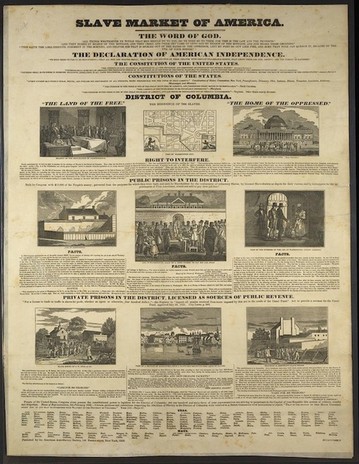Yellow House; Williams Slave Pen and Solomon Northup
Introduction
Text-to-speech Audio
Images
The Yellow House was one of the most notorious slave pens in the city. This abolitionist broadside hoped to highlight the tragic irony of the slave trade being conducted in the nation's capitol.

Backstory and Context
Text-to-speech Audio
The Yellow House was the point of transition from freedom to slavery for many escaped slaves, as well as free men and women of color who were kidnapped illegally by men who claimed they were runaways. Men, women, and children were held in this jail under horrific conditions pending their sale various areas of the South. Until Congress banned the sale of slaves (but not slavery itself) within the city limits, Washington had many slave pens “within the very shadow of the Capitol.”
William H. Williams owned the Yellow House, a slave pen described as a three-story brick dwelling, covered with plaster, painted yellow and standing within viewing distance of the Capitol. The precise location of the “Yellow House” is difficult to discern. In 1850, Smithsonian regent Jefferson Davis, remarked of this structure, "It is the house by which all must go who wish to reach the building of the Smithsonian Institution." As a result, it would have been located somewhere between 7th and 8th Streets, just south of the Smithsonian Institution grounds.
Proprietor William H. William's firm owned and operated two slave-trading ships, the Tribune and the Uncas. The broadside featured on this page shows images of the Yellow House and other slave pens in Washington and Alexandria. The top of the abolitionist broadside shows two contrasting scenes. The first depicts a reading of the Declaration of Independence under the caption "The Land of the Free." The second shows slaves being led past the capitol with the caption "The Home of the Oppressed."
Sources
Williams Private Jail, Histories of the National Mall, http://mallhistory.org/items/show/45
Kraus, Theresa. Was FAA HQ the Site of a Notorious Slave Pen?. Federal Aviation Administration website. Accessed April 02, 2018. https://www.faa.gov/about/history/milestones/media/Was_FAA_HQ_the_Site_of_a_Notorious_Slave_Pen.pdf.


